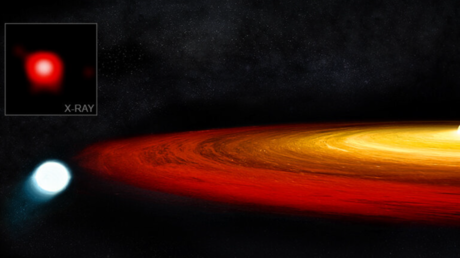
An extremely rare close call between a red giant star and a black hole has been captured by powerful NASA and ESA tech, revealing a key chapter in a cosmic saga that will likely continue for a trillion years.
The fatal celestial event is unfolding in the galaxy GSN 069 – about 250 million light years away from Earth. The black hole in question is roughly 400,000 times the mass of the sun, making it small by supermassive black hole standards, but still terrifying in scale.
Meanwhile, the red giant, caught in the black hole’s gravitational pull, had its outer layers of hydrogen stripped away, leaving only the core of the star – the white dwarf – behind to reveal its narrow escape to us here on Earth through bursts of x-rays.
“In my interpretation of the x-ray data the white dwarf survived, but it did not escape,” said Andrew King of the University of Leicester in the UK, who studied the data from the ESA and NASA. “It is now caught in an elliptical orbit around the black hole, making one trip around about once every nine hours.”
In other words, the remaining white dwarf orbits its attacker three times daily, as the black hole strips layers away whenever the star comes too close.
Every time the black hole tears away more matter from the star, it releases a burst of x-rays visible by NASA’s Chandra X-ray Observatory and the ESA’s XMM-Newton. In space, no one can hear you scream – they can just observe your demise from 250 million light years away.
The researchers are also anticipating the release of gravitational waves by the black hole and white dwarf as they continue their dance of death. Even though the star’s loss of mass will cause its orbit to round out and expand, scientists predict only one outcome: certain doom.
“It will try hard to get away, but there is no escape. The black hole will eat it more and more slowly, but never stop,” said King. “In principle, this loss of mass would continue until and even after the white dwarf dwindled down to the mass of Jupiter, in about a trillion years. This would be a remarkably slow and convoluted way for the universe to make a planet!”
Scientists have documented countless instances of black holes tearing stars to shreds, and surveyed the grim aftermath, but there have been very few tales of semi-survival such as this one.
While such near-miss events should be more common, there are several theories as to why we don’t encounter stellar survivors that often: either more of these huge stars simply take too long to complete their orbits around their black hole in order for us to witness the x-ray bursts, or the majority of the black holes out there are simply too big and too greedy – and don’t play with their ‘food’ for so long.
Think your friends would be interested? Share this story!




